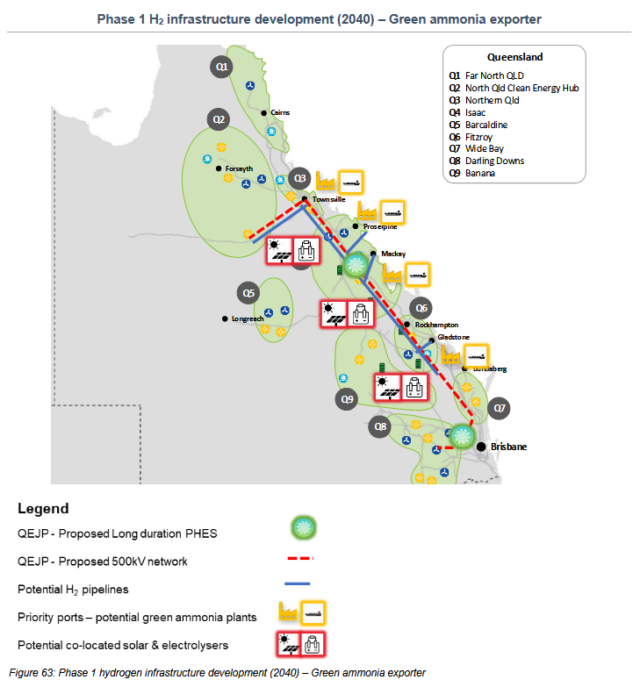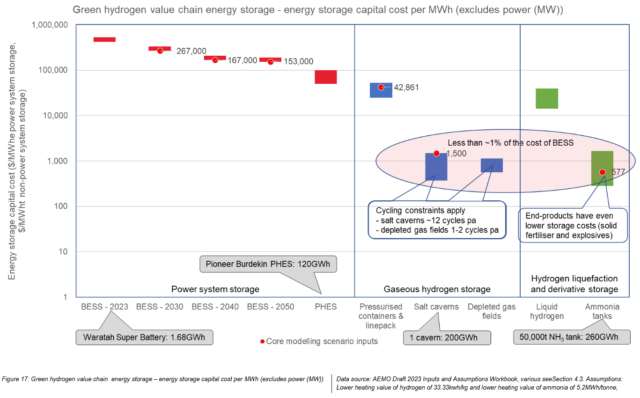New research reveals benefits of “flexible green ammonia production” in Queensland
By Julian Atchison on February 28, 2024

Click to expand. Potential Renewable Energy Zones, proposed electricity network and potential hydrogen pipelines in Queensland, which could help power a hydrogen pipeline and grid-connected, flexible, renewable ammonia production industry. Fig 63 from Fletcher et al. Queensland green ammonia value chain: Decarbonising hard-to-abate sectors and the NEM, Nov 2023.
A new joint study from Griffith & Oxford Universities explores the energy infrastructure requirements for an electrolysis-based, renewable ammonia industry in Queensland. With the right approach, multiple world-scale plants could operate on the Queensland coast, providing substantial demand response services to a renewables-dominated electricity grid.
Variable hydrogen supply not a barrier
The research team found that the extra cost of providing a constant supply of green hydrogen could be almost double that of a variable supply due to the cost of required hydrogen storage . But, instead of this being an impediment, the predicted flexibility of new-build Haber Bosch green ammonia plants and the low cost of ammonia storage could combine to make variable hydrogen supply a viable, cost-effective option.
Ammonia-based demand response: a potential answer to the Australian ‘winter problem’

Click to expand. Green hydrogen value chain energy storage options, with capital cost per MWh. Ammonia tanks (far right) represent the most cost-effective option. Fig 17 from Fletcher et al. Queensland green ammonia value chain: Decarbonising hard-to-abate sectors and the NEM, Nov 2023.
Plant turndown and the low cost of ammonia storage could also enable sector coupling benefits through the provision of demand response services to the electricity grid. The study found that by operating electrolysers and ammonia plants flexibly, demand response services such as load shifting and load curtailment could be provided to a future electricity grid at levelised costs that could be less than half of that of gas-fired peaking power generation in Queensland. This in turn allows for the potential to further decarbonise the electricity grid. In fact, “green ammonia value chain-based” demand response represents a potential answer to Australia’s winter energy problem, reducing the requirement for firming by gas-fired power in the national electricity grid:
Green ammonia demand response has the potential to contribute to addressing dunkelflaute and the ‘winter problem’. In a renewable energy dominated National Electricity Market, the ‘winter problem’ is the energy deficit caused by high demand from electrified heating coinciding with low solar PV generation. The ‘winter problem’ is the key driver of the 5-10% gas fuelled generation volume typically found in energy system modelling for a future renewable energy dominated NEM. In addition to reduced gas generation volumes, system benefits from green ammonia value chain demand response could include lower firming generation build requirements and lower CO2e emissions.
Discussion from Fletcher et al., Queensland green ammonia value chain: Decarbonising hard-to-abate sectors and the NEM, Nov 2023
Demand response services also represent a potential new income stream, particularly for organisations that own the whole integrated setup (co-located renewable energy generation, grid-connected electrolysers, hydrogen pipelines and ammonia production plants).
Prioritising policy support for ammonia
The research backs up a growing consensus that Australian policy support for hydrogen should focus on renewable ammonia production. In their official input into the review of Australia’s National Hydrogen Strategy last year, the Climateworks Centre, the Australian Energy Council, and the Institute for Energy Economics and Financial Analysis all argued that decarbonised ammonia production should be an immediate focus for policymakers. Indeed, the shortlist of projects still in the running to receive subsidies as part of the Australian government’s AUD 2 billion Hydrogen Headstart program features a number of prominent ammonia projects (Murchison, CQ-H2, the Hunter Hydrogen Hub, the Port of Newcastle and H2Kwinana).
You can read the full research paper here.